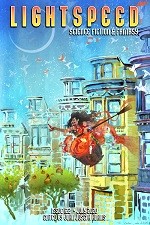“Baba Yaga and the Seven Hills” by Kristina Ten
“The End of the World Measured in Values of N” by Adam-Troy Castro
“Great Gerta and the Mermaid” by Mari Ness
“The Swallows of the Storm” by Ray Nayler
Reviewed by Kevin P Hallett
There are four original short stories in the 122nd issue of Lightspeed. Each of the stories was an interesting read.
“Baba Yaga and the Seven Hills” by Kristina Ten
In this short fantasy, Baba Yaga is a witch whose small house ran out on her. And all because she didn’t feed it enough. But Baba Yaga has a plan, the seven hills of San Francisco should provide enough magic for her to find where her house with two chicken legs is hiding.
In the city with seven hills she finds a powerful woman who sells tamales to the people. She directs Baba Yaga to a man who sells dreams in his brownies. And so, Baba Yaga travels through the city searching for a powerful magician.
This was a pleasantly paced story with an engaging prose style. But in the end the story petered out more than it ended.
“The End of the World Measured in Values of N” by Adam-Troy Castro
In Castro’s SF short, the author explores how people could react to the end of the world. Starting from a second’s notice through a warning of twenty years.
In all situations, human nature reveals it takes all sorts of people to make up humanity.
The story had some obvious and less than obvious insights into what human nature was.
“Great Gerta and the Mermaid” by Mari Ness
Gerta the pirate is single-minded in her hatred of the Lost Boys in this short fantasy set in Neverland. When she spies a Lost Boy crawling through the grass, she follows him and soon finds herself face to face with a mermaid in the lagoon.
At the point of Gerta’s cutlass, the Lost Boy claims there is a ruby at the bottom of the sea that kills pirates. Gerta wants it for Captain Hook, the Lost Boy wants it for Peter Pan, and the mermaid just wants it. Can they work together to retrieve this red ruby from the sea floor?
The author used humorous prose that stretched out the story. But sometimes the overuse of humor can slow a story down and make it tedious instead.
“The Swallows of the Storm” by Ray Nayler
A conservation biologist, Nino is investigating small clean holes in this SF short. The holes appear through people, animals, plants and even rocks. But why are these people and animals being killed?
In the throws of a climate disaster, the world’s sea levels rise, and forests burn. Still, Nino continues to study these holes and eventually finds something creating them, an artifact that is more like a test tube for taking samples than it is a deadly weapon. And Nino develops a theory about the purpose, but who would ever believe her?
Told through a series of incidents, the author keeps the reason behind the holes until the end. An interesting mystery.
 Lightspeed
Lightspeed